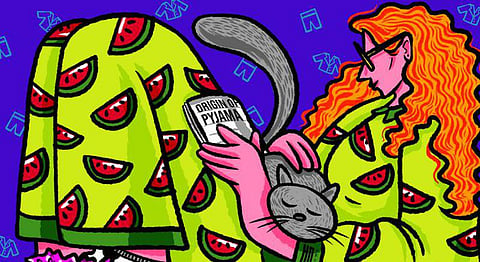
- HOMEGROWN WORLD
- #HGCREATORS
- #HGEXPLORE
- #HGVOICES
- #HGSHOP
- CAREERS
- ABOUT US
- CONTACT US

2020 could rightly be called the year of the biggest fashion revolution. Unlikely, you say?
Having compelled all of us spending almost all our waking hours at home, 2020 truly did away with the best of couture. All our formals melted away (well, at least our formal trousers) and were incredulously but seamlessly replaced by loose, comfortable jammies. All those pyjamas that had been clumsily tucked under the bottom of the cupboard before the world got socially-distanced, are out and about now and have seemed to become the official uniform of 2020.
Pyjamas are truly the epitome of comfort. But, where did the attire originate?
We might have the answer.
Derived from the Hindi word, ‘pae jama’, the ‘pyjama’ or ‘pajama’ is a type of loose trousers originally worn in the Ottoman Empire in the 13th century.
Traditionally worn by men and women throughout South Asia and the Middle East, including Bangladesh, Pakistan, Iran, and southern India, pyjamas of the bygone, not at all different from those of today, were loose trousers or drawers with a cord or hamstring to tie around the waist. They were generally paired with a belted tunic which fell to the wearer’s knees. Such a combination of garments assured comfort and also a good night’s sleep when at home.
However, the tradition was limited to the Asian sub-continent, and it was only in the 1800s that the British made it popular all over the world. If you’re wondering, before pyjamas became popular, people usually slept naked or in their undergarments. Gross? You bet. But you cannot blame them; you need to feel cosy to sleep!
Historical Allusions
This garment was mentioned in the travelogue of a Frenchman named Jean de Thevenot who was held captive in Goa in the 1600s. In the travelogue, he mentions that pyjamas were not new to the world in the 1600s, and that the Portuguese had always worn it while going to bed. He even went to the extent to state that the Portuguese in India wouldn’t sleep without them!
The ‘Mogul’s breeches’ (the English version of the pyjama) as lounging attire were introduced in the 17th century in England, a fashion that grew to be short-lived. The first documentation in English is an 1801 reference to “Tippoo Sultaun’s wardrobe [...] pai jamahs, or drawers”, and by 1854, visitors to British India were advised that most Europeans wore ‘pyjamas’ for afternoon naps. From about 1870, during the Victorian period, pyjamas steadily replaced the traditional nightdress in England and Europe as male sleeping attire.
Appropriation of the Pyjama by the West in the 20th Century
In the 1920s, there was a massive ‘Pyjama Boom’ the world over, when the pyjama was adopted by the Europeans. In 1924, it was recorded that both men and women wore colourful pyjamas made out of rich fabric to the lido (a public, open-air swimming pool). Pyjamas were so much in vogue in those times that they started exceeding the demand for night dresses and other kinds of sleepwear. Even industry workers found that they could work better in pyjamas than the usual attire.
Modern-Day Pyjamas
Since its earlier days of being an Indian loose-bottom wear, the pyjama has evolved into an article of clothing having many different styles. Now, there are ‘pyjamas’ in different fabrics, designs, cuts, and embellishments. The most popular variations of the pyjama (singular for the traditional trousers) are the ‘salwar’ and the ‘churidar’. While the former is a loose and trousers that are worn with a ‘kurta’ and ‘dupatta’— the latter is loose above the knee and tightens up at the calf. There are many other variations to the salwar that are worn by the youth of the country such as ‘Patiala salwar’, ‘Jodhpuri salwar’, ‘Sidha Paijama,’ ‘Shalwar’, ‘Kalidar’ and ‘Afghani Salwar’.
Other variations of ‘pyjamas’ include Beach Pyjamas, Lounge Pants, Night Pyjamas etc. Cotton and soft fabrics like silks and satins are more preferred in pyjamas. These pyjamas are designed in polka dots, paisleys plain colours, floral designs, cartoons, etc. Another variation of the pyjama is the ‘palazzo’, which is popular among women. Being easy-breezy pants, these are very comfortable to wear for extended periods of time. With time, therefore, pyjama evolved from being an attire you only wore in your bedroom, to one that could be worn to even weddings, parties or informal social gatherings. The multipurpose use of the pyjama is what has made it such a common item in all households in India as well as in many parts of the world.
Pyjama Brands
Off late, pyjamas have been tailored and customised to suit the taste of customers by leading international brands like Dolce & Gabbana, Desmond & Dempsey, Olivia Von Halle, The Sleep Shirt and others.
If you enjoyed reading this article, we suggest you also read:
